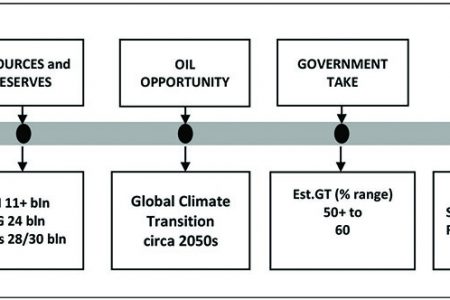Wrap-up on the modelled second driver and its metrics, Guyana’s window for open crude oil exports
Introduction Today’s column concludes my assessment of the second of four modeled drivers and its metrics.
Introduction Today’s column concludes my assessment of the second of four modeled drivers and its metrics.

Introduction Last week’s column concluded my consideration of the first of four modelled drivers [that is, Guyana’s oil and gas resources and reserves] and their related metrics, as displayed in the analytical framework I am using here [see January 28, 2023 column.]

Introduction As indicated in last week’s column, today’s column focuses on two items.

Introduction Today’s column interrogates, rather summarily, the key crude oil metrics linked to Guyana, which within the space of four years, has been already hailed as the Americas’ fastest rising Petrostate.

Introduction In today’s column I commence an elaboration, in two parts, of the modeling of the petroleum metrics that undergird the Buxton Proposal.

Introduction Today’s column continues my description of the nitty-gritty features or the key nuts and bolts of the universal basic income [UBI] mechanism, the Buxton Proposal, which I have long advocated for Guyana as the most effective means of eradicating its persistent poverty.
Introduction In today’s column I treat with 1] the operationalizing, scheduling and execution of the Buxton Proposal and 2] start my coverage of the Whys and Wherefores of cash transfers.

Introduction, proximate origin Some bizarre motives have been attributed to me for naming the suggested UBI mechanism for eradicating persistent poverty in Guyana the Buxton Proposal.
Introduction Today’s column provides a general introduction to my re-visit of the Buxton Proposal and the intended structure of my presentation.
Introduction Today’s column engages the IMF’s recent publication on Universal Basic Income, UBI schemes as a direct complement to last week’s, which engaged the World Bank study on the same topic.
Introduction Today’s and next week’s column combine to form a preface to my intended task of updating the Buxton Proposal.

Introduction Today’s column engages the fifth of the six listed social protection mechanisms [state employment] that are widely utilized to address persistent poverty in emerging oil-rich economies.
Introduction Last week’s column referenced six mechanisms utilized by oil-rich economies pursuing poverty eradication.
Introduction Back in early September this year I received a circular appeal from the Tri-continental Research Institute that was sent to its network of fellow Researchers in the Global South.
Introduction Today’s column introduces multi-dimensional measures of poverty in Guyana. I share the view that the best starting point for this topic, is through an introduction of the United Nations Human Development Report, UN, HDR and its Index HDI As the UNDP states, the HDI is a “summary measure for assessing long-term progress in three basic dimensions of human development: a long and healthy life, access to knowledge and a decent standard of living.

Introduction Last week’s column illustrated that for most of the 2000s Guyana’s poverty theorizing as well as its policy prescriptions have been constructed on the basis of data derived from headcount or headcount–related survey studies.This

Introduction In response to the Tricontinental Institute of Social Research’s circular call for assistance for crafting a new development theory and practice that seeks to release the poor from their persistent poverty, I ventured a response based on this long-running series on Guyana as the “newest and fastest rising petrostate in the Americas.”
INTRODUCTION Today’s column continues consideration of the circular communication sent to me by the Tricontinental Institute of Social Research, a network of research bodies in the Global South which, urges my contribution towards the construction of “a new development theory that did not leave the poor trapped in their poverty”.
Introduction Last week’s column wrapped- up my consideration of ExxonMobil’s performance as a leading protagonist against global climate policy transition.
Introduction In today’s column I take on board more frontally the added reputational and business risks, which flow from the circumstance that ExxonMobil [Guyana’s lead oil Contractor] displays the characteristics of a zombie corporation as that term is commonly understood in the formularization of the dynamics of zombie firms in business and economics.
The ePaper edition, on the Web & in stores for Android, iPhone & iPad.
Included free with your web subscription. Learn more.